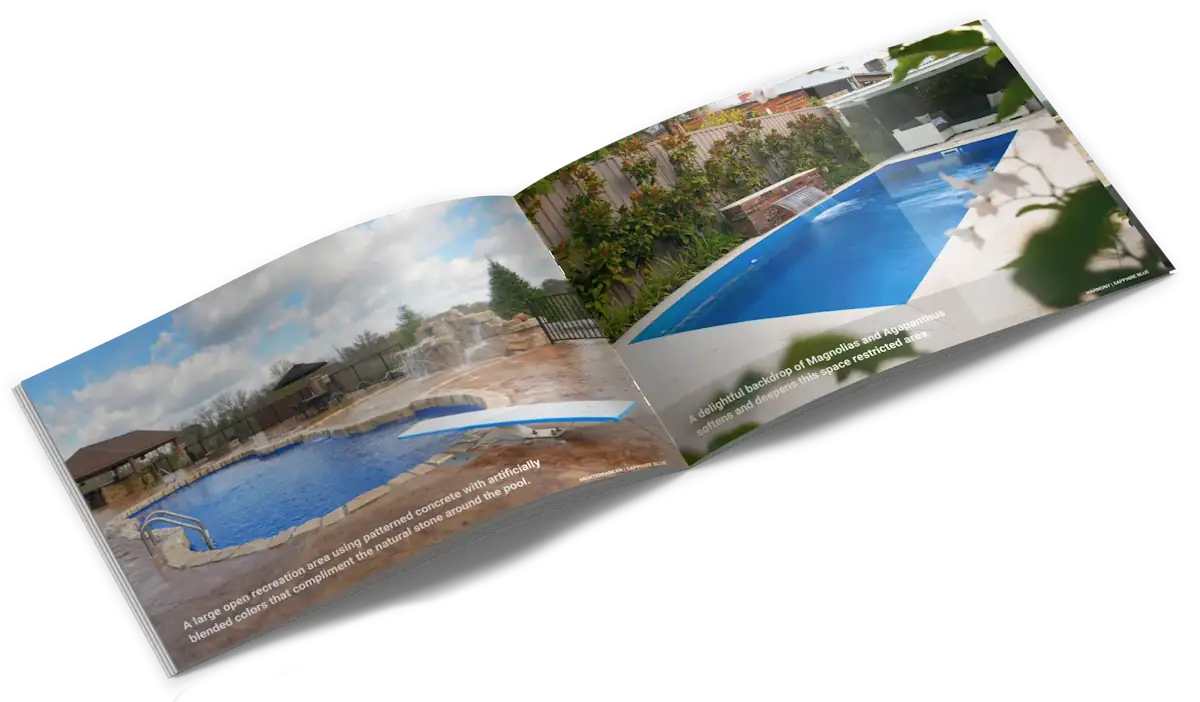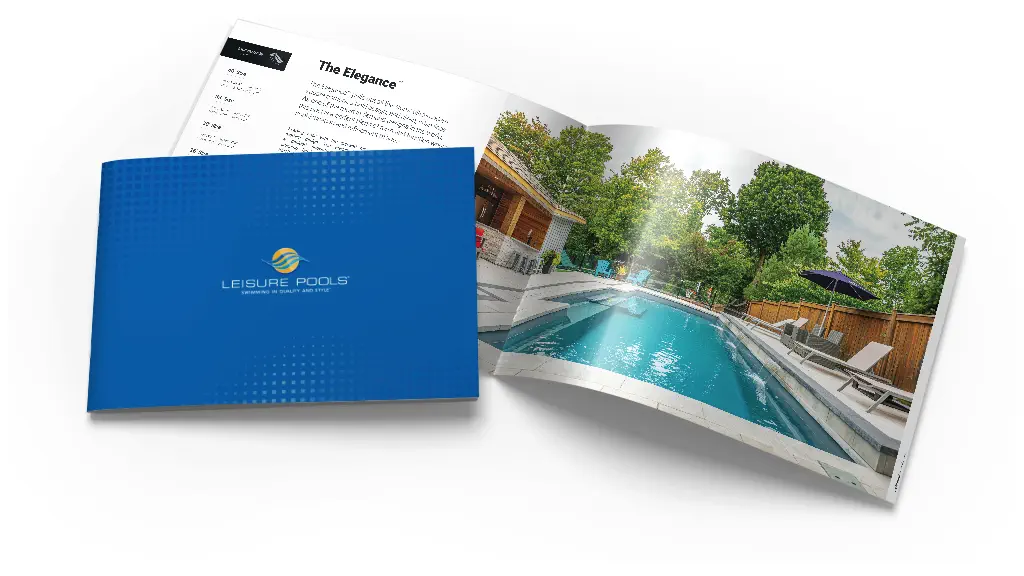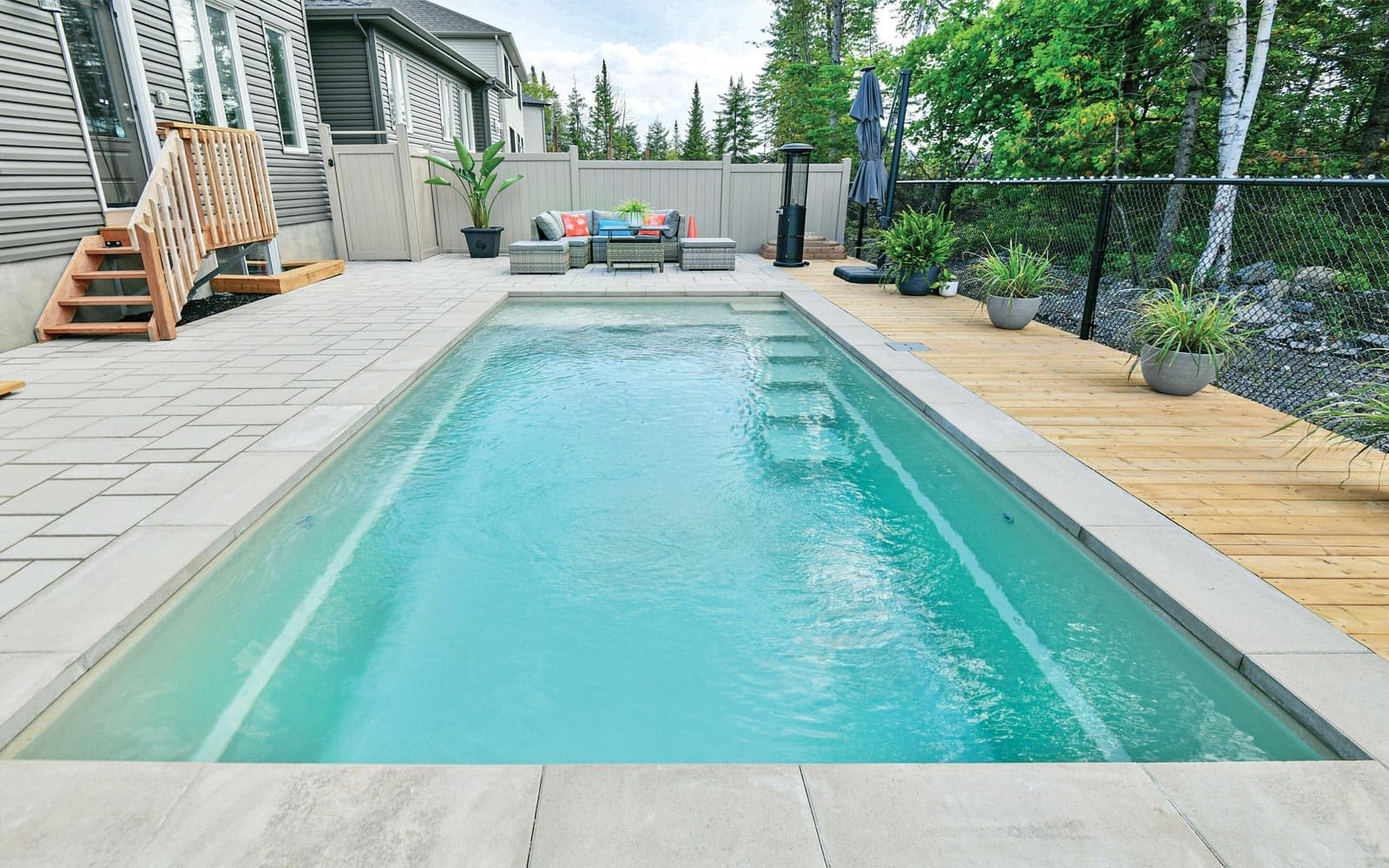
Why Fiberglass Pools Are The Most Affordable

Is a Fiberglass Pool Cheaper and More Affordable Than Concrete and Vinyl Liner Pools?
Two of the most common questions homeowners ask regarding an inground swimming pool are:
- How affordable are inground pools?
- How much does it cost to maintain an inground swimming pool?
The answer to both of these questions is, it varies. Swimming pool affordability depends on how you answer the following fundamental questions.
Top 10 Contributing Factors to Inground Swimming Pool Costs
- Area of the country
- Length of pool season
- Lifestyle
- Type of inground swimming pool
- Regular ongoing maintenance
- Scheduled preventive maintenance
- Water chemistry maintenance
- Pool pad equipment
- Landscape
- Hardscape
We’ll break down these factors into three more manageable groupings: Cost of building an inground swimming pool, regular maintenance costs, and long-term maintenance costs. Then, we’ll wrap it up so you can make an informed decision.
Cost of Building an Inground Swimming Pool
Creating a backyard Life of Leisure is more popular and more affordable than ever before. Just look at the coverage of outdoor living on the Discovery Network’s Home and Garden Television (HGTV) and the Do-it-Yourself (DIY) networks alone. In fact, dreamers of incredible outdoor spaces turn to social media such as Pinterest, Instagram, Facebook, and YouTube in ever-increasing numbers.
You can do more than dream of pool ownership when you have the right information upfront. It’s essential to understand your short and long-term equipment and maintenance costs, not just the costs of building an inground swimming pool before diving in.
Startup Costs: Inground Swimming Pool Costs
The return of your swimming pool investment (ROI) should be measured on dollars and time and NOT sentiment. Before deciding whether you’re genuinely invested in pool ownership, you should identify just what you’re willing to spend in cold, hard cash and time on maintenance.
It’s the Best Time to Build a New Pool – Ever!
Your outdoor function and finishes should reflect your personality, lifestyle, and the architecture of your home. Are you looking for a sleek swimming pool design to mimic the architectural simplicity of your mid-century modern home? Or, in contrast, would a swimming pool nestled in a lush landscape to create the feel of a natural spring-fed treasure be more your vibe? Your theming will set the tone for your entire landscape and the required budget to get started.
When it comes to the pool, focus first on the size, shape, finish, and realistic expectations for use before getting into how it first into the surroundings and amenities. Then build on step-by-step with your contractors for a cohesive design and all-inclusive budget to keep it affordable.
Selecting the Inground Swimming Pool Type For You
There are three types of inground swimming pools – composite fiberglass, vinyl liner, and concrete. Each swimming pool type offers features and benefits that can suit your desired look, feel, and budget. However, it’s essential to also look at how these materials will affect your costs over the swimming pool’s life. To learn more and compare these three types of inground pools, read our Fiberglass Pools vs. Concrete Pools (Gunite) vs. Vinyl Liner Pools article.
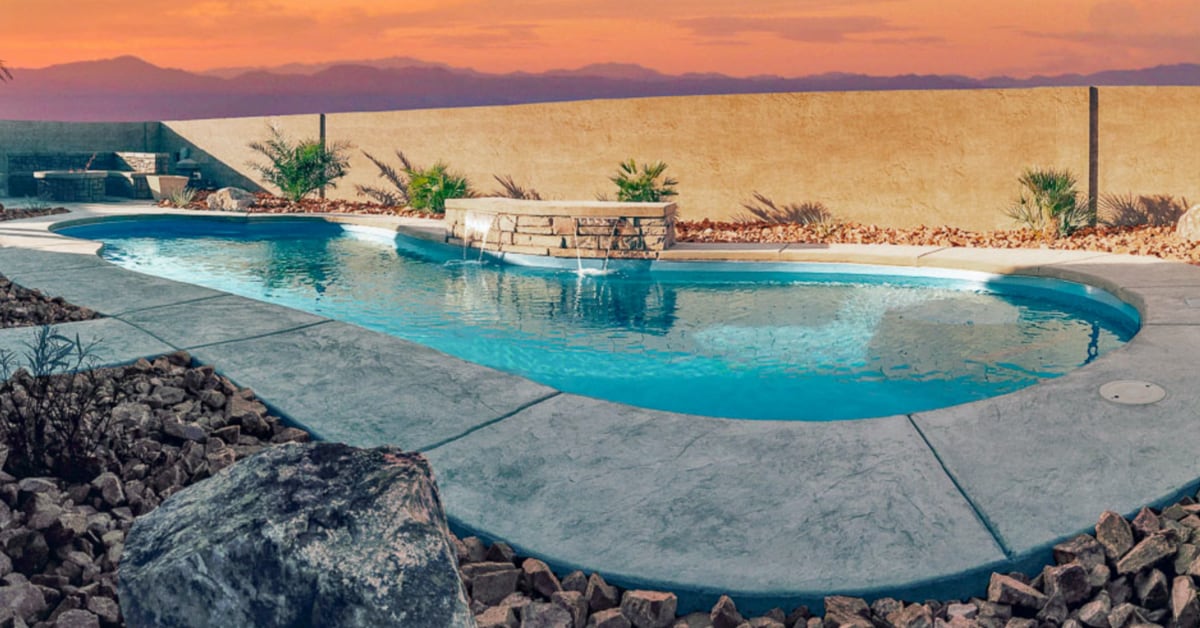
Composite Fiberglass Inground Swimming Pool
One of the highest non-monetary costs when it comes to building a swimming pool is patience. In that regard, composite fiberglass pools have a significant edge because composite fiberglass swimming pools offer the quickest gratification or what we like to call – the fastest time to swim.
The main reason fiberglass swimming pools are the fastest time to swim is that the swimming pool structures are fabricated off-site. Once the swimming pool hole is excavated, the finished fiberglass swimming pool structure is lowered into the hole by installers and a crane That generally takes an afternoon (although the time for more difficult installations may vary). To complete the pool area, all that’s required is for the decking and landscaping to be completed. Fiberglass swimming pools can be fully installed and operational in as little as four days.
From a building point of view, fiberglass pools cost less because they are formed offsite by the manufacturer’s skilled craftsmen. They’re also able to offer above-average results, at a lower cost, because they are experts in quality. Every design detail is guaranteed – size, shape, features, finish, and color. And, they can offer superior warranties because the materials used in constructing higher-end fiberglass swimming pools are far superior to the vinyl liner and concrete pools.
Today’s fiberglass swimming pools hold up better to time, the elements, chemicals, and bathers. While not all fiberglass swimming pool manufacturers, their materials, and warranties are alike, Leisure Pools offer the industry’s most durable options and boast Lifetime Structural and Osmosis Warrantees.
Vinyl and concrete pool manufacturers and builders cannot offer lifetime protection on your investment. Only fiberglass!
Average Inground Swimming Pool Costs
On average, an inground swimming pool will typically cost between $18,000 and $60,000, depending on size, options and landscaping.
This is a big gap. It will narrow once you decide on your pool type – Fiberglass vs. concrete vs. vinyl liner swimming pool. Features, equipment, fencing, decking, and landscaping also contribute to the significant cost range.
Fiberglass and vinyl-liner pools are in the more affordable range, while a custom concrete pool can cost well beyond this higher range of $60,000.
Depending on the region of the country where you live, an average fiberglass pool’s initial cost of installation is approximately $35,000 – $40,000. If you factor in the yearly maintenance cost over ten years, fiberglass pools are significantly less expensive than vinyl liner pools and concrete pools which makes it much more affordable for many families.
Maintenance Costs
Short and Long-Term Maintenance Cost Advantages
In both short and long-term maintenance categories, composite or fiberglass swimming pools offer significantly lower maintenance costs than any other pool type. They maintain their color and soft-to-the-touch finishes like no other pool type – protecting your investment.
- Lowest Short-term Maintenance Costs:
Fiberglass pools’ smooth, nonporous surfaces make water chemistry more manageable and less costly to maintain. And, their finishes also inhibit algae growth. When paired with a salt chlorinator, pool owners will find their maintenance time is further reduced, and their swimming experience is superior with silky-soft water. - Lowest Long-term Maintenance Costs:
Some fiberglass pool manufacturers — such as Leisure Pools — offer a lifetime guarantee on their pool’s color and finish, unlike vinyl and concrete pool alternatives.
The quickest way to reduce your short and long-term costs depends on you and your pool type.
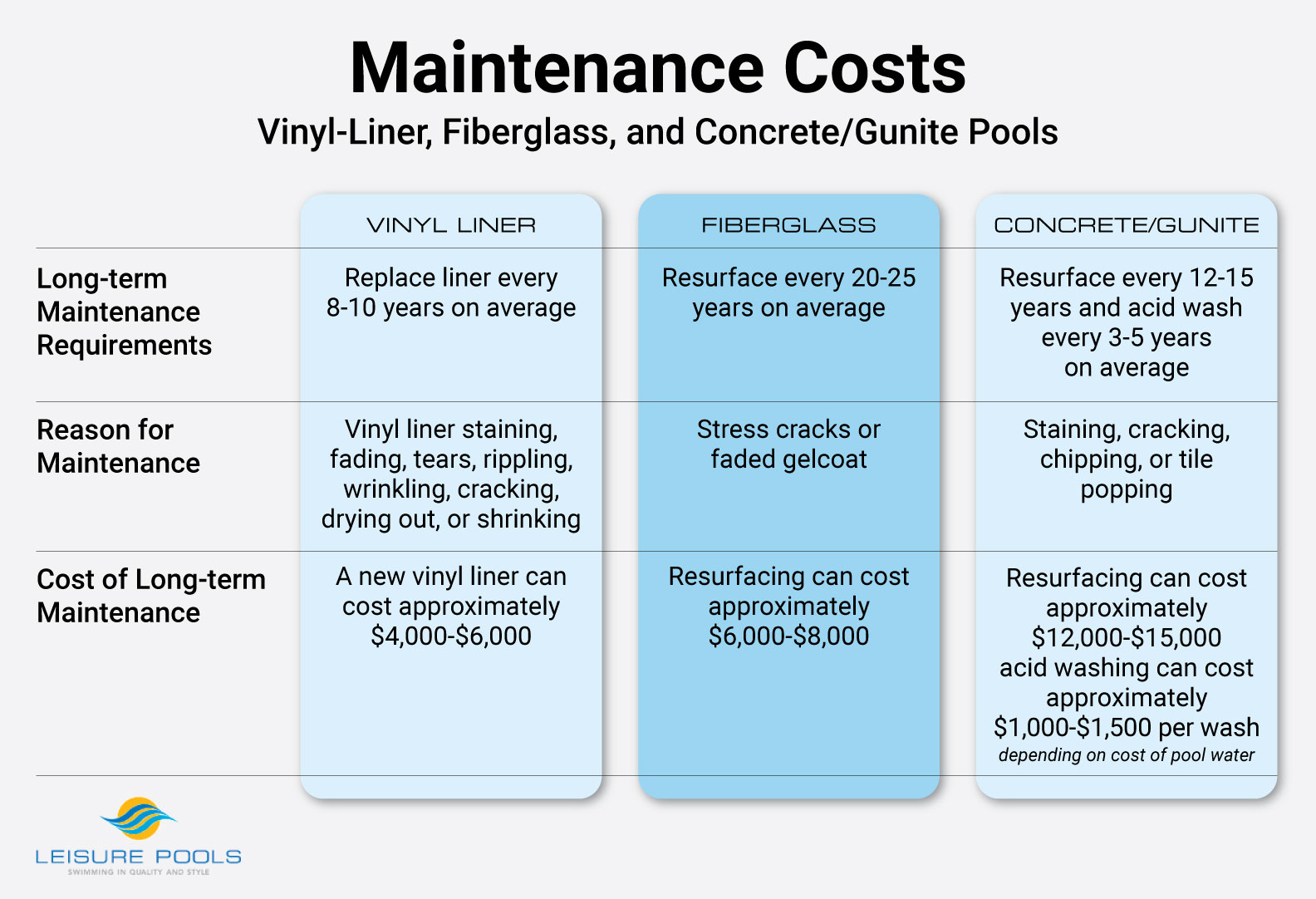
Keep your pool clean and your water in balance!
While fiberglass pools offer more straightforward and lower-cost short-term maintenance, the fact is, you still need to be vigilant. Keep your swimming pool clean, test your water often, and only administer needed chemicals, never more.
How often you need to clean and test your pool’s water is largely up to you and how you use the pool, and for how long.
FACT: when you keep your swimming pool’s water in balance and free of dirt and debris, the cost and time it takes to maintain your swimming pool’s water is significantly reduced. AND, doing so will protect your investment and dramatically reduce long-term maintenance costs. YES, you can alter your costs, significantly, by diligently maintaining your pool’s water. If you’re not up to the task, hire a pool professional to maintain your swimming pool. It can be argued that hiring a pro, even with weekly or bi-weekly services costs, will lower your overall costs.
Every time a pool is drained for maintenance (which should only be done in extreme circumstances in a fiberglass pool), there are substantial costs associated with new water. High additional costs with resurfacing and vinyl liner replacement include new water, chemicals to treat the new water and energy costs to filter, and in some cases, heat the new water.
Above and beyond the investment protection of a fiberglass swimming pool’s lifetime guarantee, fiberglass swimming pools offer significantly lower water chemistry maintenance. Due to their nonporous nature, the fiberglass swimming pool’s water is less susceptible to fluctuation due to the elements, bather load, and gas emissions associated only with concrete or Gunite pools.
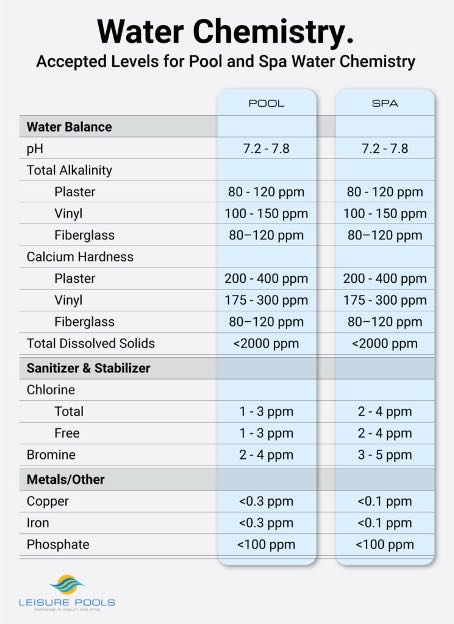
Let’s revisit the other Top 10 contributing factors to inground swimming pool costs
- Type of inground swimming pool
- Area of the country
- Length of pool season
- Lifestyle
- Regular ongoing maintenance
- Scheduled preventive maintenance
- Water chemistry maintenance
- Pool pad equipment
- Landscape
- Hardscape
Where you live greatly affects the cost of running and maintaining your swimming pool, its equipment, and its water. For instance, in the northeast, the swim season is short, and temperatures rarely rise over 90ᵒ or dip below 60ᵒ in the hight of the season. This temperature range makes it easier to maintain chemistry. Also, with less evaporation, there’s even less need for chemical replacement. Arid climate maintenance costs are dramatically higher for obvious reasons. Pools are kept open longer if closed at all. Equipment runs longer, evaporation is an issue, and higher temperatures make it challenging to maintain pool water balance due to a higher likelihood of algae growth.
Check out our complete guide to water chemistry maintenance in fiberglass pools.
The type and frequency of dirt and debris entering your swimming pool’s water vary greatly as well. Longer pool seasons lead to more debris in your pool and various regional plant and organic matter must be kept at bay by skimming often.
Rain can cause you the most trouble of all regional issues. Rainwater will dilute your water’s chemicals, often leading to cloudy water. It’s important to test your pool’s water immediately after a rainstorm to replenish what was lost.
When rainwater and landscape runoff enter a pool’s water, they can also alter your water’s calcium hardness, total dissolved solids (TDS) and other chemical levels through the dilution of the chemicals in your pool water. Rainwater is acidic, which will lower your swimming pool water’s pH. It’s imperative that you not let your pH fall below 7.2 Parts per million (PPM). Low pH will make your water corrosive and damage your pool’s surfaces and equipment. And, chlorine will expend itself more rapidly.
Lifestyle also has a lot to do with swimming pool maintenance. Do you throw a lot of pool parties? Do you have a constant stream of swimmers? Do they shower before swimming? While these might sound like personal questions, bathers, the two and four-legged kinds, significantly affect your water chemistry. Hairspray, makeup, soap, shampoo, sunblock, etc., will all throw off water chemistry. Most everything can and will negatively affect your swimming pool water balance. As we’ve repeatedly said in all Leisure Pools articles, test frequently to maintain optimum water chemistry levels.
Properly functioning, sized and efficient swimming pool equipment will contribute to lower maintenance costs. How much depends on what you have on your pool pad. A trained professional can direct you on how you can save energy, water, and chemicals – by right-sizing equipment for your plumbing and pool size. They will also help you consider smarter automated swimming pool equipment that will run only when you need it. They’ll also recommend energy and water-conserving equipment such as variable-speed pool pumps, heat pumps to heat your pool’s water, and cartridge filters that don’t require backwashing. What’s right for you and your swimming pool can only be determined when a pool professional knows your particular application.
Hardscapes, landscaping, and of course features, furnishings and décor are pool dreamer specific. Natural stone decking and pavers will add drama and a higher price tag over other materials. The addition of fire and water features, an outdoor kitchen, and luxurious furnishings that rival your indoors will add comfort and style at considerable cost.
The key to lowering costs in these areas is to plan many of these poolside additions at the same time you’re scoping your build. While some items may need to move out to a 2, 5, or even 10-year plan, there are some economies of scale that can help you lower your costs at build time. Anything such as digging, trenching, and heavy lifting that can be done when your contractors are installing the pool and surrounding hard and landscaping design can lower costs significantly by using equipment already there. Also, there’s less chance of surprises and overages when builders, architects, designers, and various trades work together on an overall plan.
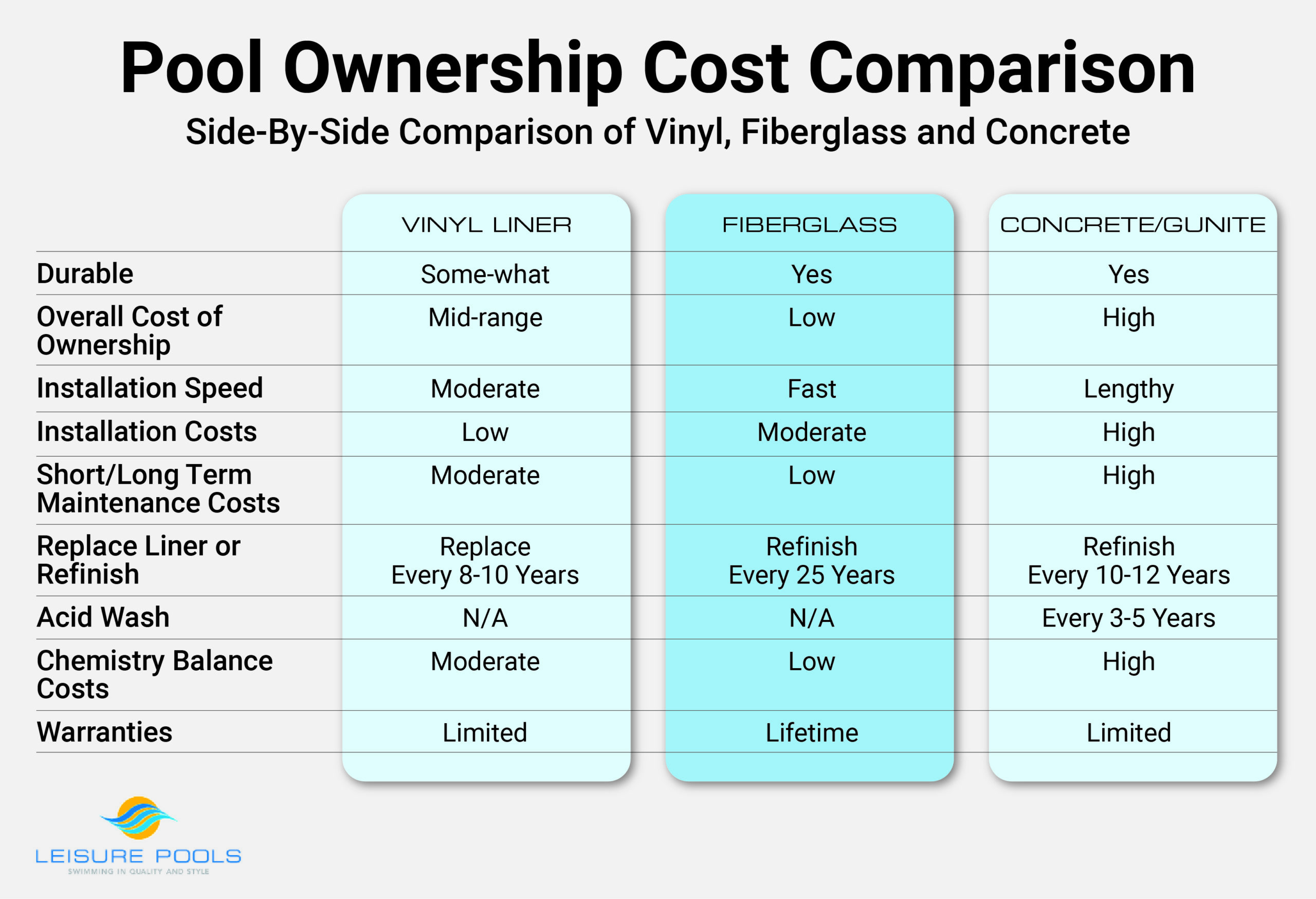
To Recap
Not only is now the perfect time to plan for an inground swimming pool, but it’s also more affordable than ever.
The top reasons to select a fiberglass swimming pool from Leisure Pools over their competition can be directly linked to affordability, not just flexibility and beauty.
Speed of Installation – Quickest time to swim
Time is money! Your fiberglass swimming pool comes directly from the manufacturing facility, pre-made and ready to install. You can be swimming in as little as four days (depending on inspection requirements in your area). Compare that to a concrete pool that can take months to complete, and during that time, your backyard looks a mess!
Smooth Finish
Smooth finishes of fiberglass swimming pools cost less to keep clean. Fiberglass swimming pools have a smooth, clean gel coat finish that is non-abrasive. There are no sharp edges or rough finishes. Compare that to some pebble pools that are so abrasive they can harm your skin. The Gelcoat smooth finish is nonporous, so it cleans easily and is very stain resistant.
Low Chemical Usage
Fiberglass pool’s surfaces are chemically inert, so there is nothing in the pool surface that can alter the water chemistry. This leads to very low chemical usage and considerable cost savings on maintaining your pool.
Surprising Strength
The high tensile strength of fiberglass allows the pool shell to flex without cracking to accommodate earth movement.
Warranty
When selecting your fiberglass pool, be sure to ask manufacturers about their warranty policies. Unlike concrete or vinyl-liner pool manufacturers, some fiberglass pool manufactures, such as Leisure Pools, can offer you a lifetime warranty.
Great Designs
Fiberglass swimming pools have come a long way. Integrated features, such as tanning ledges and spas, are included in the pool costs.
Automation Compatibility
Salt chlorinators and ozone systems work seamlessly with fiberglass swimming pools. Automating chlorination will reduce your chemical costs.
For more on swimming pool side-by-side comparisons, read our Inground Pool Comparison article. In this article, we compare fiberglass vs. vinyl liner pools and fiberglass vs. concrete pools. Also, feel free to reach out to us directly with any additional questions your may have regarding fiberglass pools.

